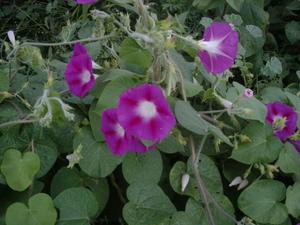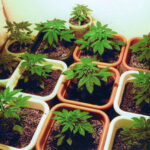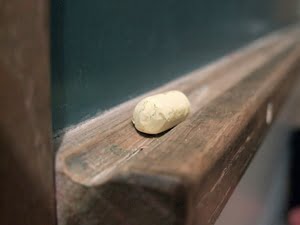Propagating stem cuttings takes time and not every cutting survives. The plant cutting must generate enough energy from the stored chlorophyll in the stem and leaves to heal itself and grow a new root system. The chlorophyll feeds the cutting so a perfect clone of the mother plant results when the roots grow. It may take up to 3 months for stem cuttings to root sufficiently enough to sustain the new plant. When the cuttings do take root and grow, the satisfaction of knowing you made it happen, is wonderful. You saved money and added more plants to your landscape. Read on to learn how to propagate stem cuttings.
The Process:
Make a clean cut using a sharp knife or pruning shears approximately 6 to 8 inches from the tip of the stems. These cuttings are known as stem cuttings.
Remove any flowers and all but the top 2 or 3 leaves by gently grasping the stem between your thumb and forefinger and sliding your hand down the stem cutting, exposing the bare stem. This allows the cutting to use the chlorophyll for root production instead of leaf or fruit production. Place the cuttings in water until you are ready to plant.
Wet the potting soil with warm water so the moisture penetrates the soil. Do not saturate the soil but allow it to be the consistency of a damp sponge. Fill the growing container with the soil. Use your finger to make holes in the soil for the stem cuttings.
Pour 2 tbsp. of rooting compound into a disposable container. Dip the stem cuttings into the rooting compound and shake off any excess. Stick the cuttings into the soil with at least one leaf node below the surface of the soil. Gently push the soil into place around the stems.
Cover the growing tray with a clear plastic bag or plastic wrap. This helps create a humid environment to keep the soil moist and generate even temperatures. Place the growing tray in a sunny location but out of direct sunlight.
Monitor the stem cuttings daily and remove any dead or dying stems. To avoid over saturation, water the cuttings with a spray bottle of water when the soil becomes dry. Continue monitoring the stem cuttings until new growth starts to form. Gently tug on the cuttings to feel for resistance which signifies the root system has developed.
Transplant the stem cuttings into individual containers and continue growing while gradually increasing exposure to sunlight. When the new plants can withstand normal growing conditions for the plant, move to a permanent location in the landscape.
FYI:
The rooting hormone is available at almost every garden center in powder or liquid form. I prefer powder because you get the same strength formula every time. Liquid formulas work great for making hardwood cuttings, where you need extra rooting power. For stem cuttings, the powdered hormone works well.
The amount of water used to moisten the potting soil is dependent upon the soil mixture and the size of the growing pot. Certain potting soils appear damp and retain moisture so less water is needed than a potting soil containing a higher level of peat moss or other planting additives. Soil which allows standing water to form on the top of the growing tray is too wet and the cuttings will rot.
You can take several cuttings from one plant and certain plants, like forsythia or lilac, will produce hundreds of cuttings for you to root and grow. Have fun filling your yard with all the new plants.







